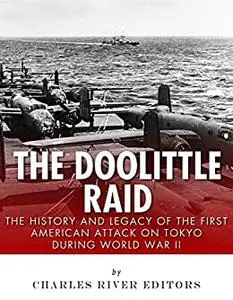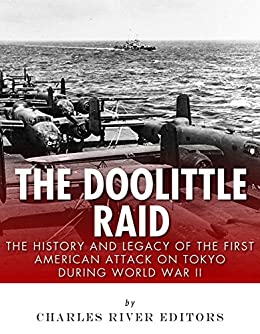The Doolittle Raid: The History and Legacy of the First American Attack on Tokyo During World War II by Charles River Editors
English | January 4, 2015 | ISBN: 1505971012 | 61 pages | EPUB | 1.62 Mb
English | January 4, 2015 | ISBN: 1505971012 | 61 pages | EPUB | 1.62 Mb
*Includes pictures *Explains the planning and training for the raid *Includes accounts of the raid written by Doolittle and other survivors *Includes a bibliography for further reading *Includes a table of contents “The Japanese people had been told they were invulnerable … An attack on the Japanese homeland would cause confusion in the minds of the Japanese people and sow doubt about the reliability of their leaders. There was a second, and equally important, psychological reason for this attack … Americans badly needed a morale boost.” – Jimmy Doolittle All Americans are familiar with the “day that will live in infamy.” At 9:30 a.m. on Sunday, December 7, 1941, Pearl Harbor, the advanced base of the United States Navy’s Pacific Fleet, was ablaze. It had been smashed by aircraft launched by the carriers of the Imperial Japanese Navy. All eight battleships had been sunk or badly damaged, 350 aircraft had been knocked out, and over 2,000 Americans lay dead. Indelible images of the USS Arizona exploding and the USS Oklahoma capsizing and floating upside down have been ingrained in the American conscience ever since. In less than an hour and a half the Japanese had almost wiped out America’s entire naval presence in the Pacific. The Americans would turn the war in the Pacific around in the middle of 1942, but in the wake of Pearl Harbor and the Japanese invasion of the Philippines, the country was in desperate need of a morale boost, and it would come in the form of the Doolittle Raid. In part to show that the Japanese were not invincible, and in part to reassure the American public that the nation would not lose the war, the Doolittle Raid included both Army and Navy units that launched 16 land-based medium bombers from an aircraft carrier, a feat that was the first of its kind but also one involving a great deal of risk. Getting the bombers and carriers in place to execute the mission involved much strategic planning and cooperation within the American military, and had it failed, it could have dealt a serious blow to the Americans’ Pacific presence due to the nation’s limited resources in that theater. As if getting in position wasn’t challenging enough, the raid was never designed to include a round trip back to the carrier. Given the size of the bombers, the planes were unable to land back on the USS Hornet, so the plan was to have them fly over Japan and ditch in China after bombing Tokyo. While most of the crew would survive the mission, a few died during the raid, all of the planes were lost, and Japanese search parties eventually captured a number of Americans and executed three of them. One of the crews landed in the Soviet Union and would end up being interned there for a year. From a tactical standpoint, the raid accomplished nothing of note, and Doolittle actually thought he would be punished for the results, but the Doolittle Raid served its purpose of boosting American resolve and demonstrating to the Japanese that they could be attacked at home as well. Furthermore, the Doolittle Raid showed the importance of air power in the war. It helped convince military planners of the power of a strong air force that could not only shift the balance of battles but could also hit military-industrial areas from long-range and thus cripple a nation’s war-making abilities. The Japanese would take the capabilities of airplanes into account when formulating how to defend their empire, and it would help compel their leaders to make decisions such as the ones that led to the decisive Battle of Midway later in 1942. The Doolittle Raid chronicles the history and legacy of one of World War II’s most audacious air raids. Along with pictures of important people, places, and events, you will learn about the Doolittle Raid like never before, in no time at all.
Feel Free to contact me for book requests, informations or feedbacks.
Without You And Your Support We Can’t Continue
Thanks For Buying Premium From My Links For Support
Without You And Your Support We Can’t Continue
Thanks For Buying Premium From My Links For Support



